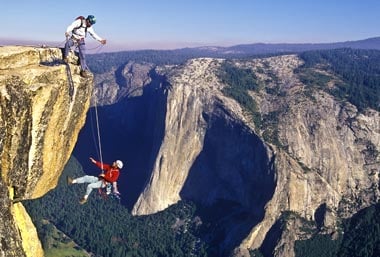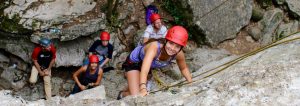- Home
- About Us
- India Tour
- Packages
- Religious Tours
- Adventures Tour
- Rajasthan Tour
- Honeymoon Tours
- Reservation
- Contact Us
If you want to try rock climbing, but don’t want to commit to a whole week before knowing whether or not you like it, a mixed-activity adventure is perfect. Forget trying to figure it out as best you can in a sweaty, indoor climbing gym: get outside and see spectacular scenery while you learn the skills you need.
Rock climbing holidays are a daring, exciting way to spend time in the mountains. If you’re a keen walker or mountain biker wanting to mix it up, spending one day of your next mountain escape trying rock climbing is a brilliant place to start…

Rock climbing possesses all the technical elements of mountaineering but does not take place in alpine conditions. It is, therefore, a sport in its own right. The objective is to climb rock walls using nothing but your hands and feet. It is about defying gravity at all odds, and also about testing your physical and mental strength. The exhilaration of completing even a 10-minute ‘boulder problem’ or traverse leaves you “pumped up” and rejuvenated. Rock climbing is like traditional climbing but it is practiced on routes previously equipped with bolts and anchors. This allows the sport to be practiced with greater safety and with smaller investment in equipment. This type of climbing can be practiced both on natural rocks and on artificial walls. On rocks, the route lengths are typically between 25m and 50m (between 82ft and 164ft), but it is common to find routes several times these lengths. Climbing walls are generally built of concrete or wood panels, to which footholds are bolted, similar to the ones found on rock. The wall’s height and form depends largely on the purpose for which it was constructed training or competition.
The first references to rock climbing as an independent discipline apart from mountaineering date back to 1911, to Europe, where there was a distinction between free and artificial climbing the difference being that the latter was practiced without any support or equipment at all. Between the 1930s and the 1950s, artificial climbing developed greatly, and in the 1950s pitons were introduced. In the 1960s the climbing harness was developed, an important safety development. It was in the 1970s when people started to talk about free climbing nothing of the pitons and drilling that damaged the rocks, but with the focus solely on ascending by the climber’s own means. This, however, limited the increase in difficulty levels, which was the reason why at the end of the 70s the spit a pressure nail with an expander and a metal nucleus which is inserted in a hole in the rock, and a perforated board for the snap harness was introduced. For some, the invention of the spit was the beginning of modern rock climbing.
The mountaineering institutes in India started rock climbing mainly to “train for mountaineering”. The sport started gaining popularity in the 1980s and the impetus largely came from visiting climbers and from Indians who got opportunities to climb overseas. Moreover, a number of Indian climbers have done courses in places such as ENSA, the national alpine skiing school in Chamonix, France, and this has led to the development of many climbing areas, and, subsequently, to higher climbing standards in the country. With more and more Indians taking to the sport, and even performingwell at international levels, rock climbing has a promising future in India. Rock climbing certainly has much going for it. There is a great sense of discovery and exploration while climbing in India. Climbing areas are often close to interesting historical or cultural sites, while the potential to discover new areas and routes is huge. In addition, there is a whole range of climbs possible in the 200m-1000m range, from the ‘big walls’ of the Himalayas (the Gangotri gorge) to the volcanic rock formations of Mount Abu (Rajasthan) and the magnificent granite formations of Hampi (Karnataka). And unlike the popular climbing areas in Europe and North America, which have queues of climbers waiting to attempt classic climbs, and where the holds are permanently caked with chalk, Indian climbing routes, even on public holidays, are rarely ever crowded. One can enjoy the solitude on the rocks.
Rock climbing sites abound in India. As the activity becomes more popular across the country, new crags are being discovered and climbed by enthusiasts. This is not an exhaustive list, and only some popular and world-class climbing areas in the country are listed and described here.
North
Delhi (best season, October to March): All three rock-climbing areas are located in Delhi’s green belt. They give you a good opportunity to get away from the pollution and madness of Delhi without planning much in advance.
Ramjas Rocks Located in West Patel Nagar in the heart of Delhi, these rocks are sandstone walls and slabs. The rocks’ height varies between 20ft and 60ft.
PBG Rocks Located on forest land on the Delhi Ridge, land which comes under the control of the President’s bodyguard cavalry unit, these sandstone rocks have a height of between 10ft and 30ft
Lado Sarai Situated in a park (under the control of the Delhi Development Authority) between the Qutab Minar and Saket colony. The sandstone rocks here have good friction and are 10m (approx.) high. They offer routes easy enough for the novice and challenging enough for the expert. The rocks consist of two formations called the ‘stack’ (with a 12th-century 15ft minaret on top) and ‘old man’. Cracks, face climbs even a chimney can be attempted here.
Around Delhi (best season, October to March)
Dhauj (Haryana) Located about 55km from Delhi, easily accessible from the capital. Dhauj has a scenic climbing area by a lake which is often visited by migratory birds, and offers over 250 routes of varying grades of difficulty. The solid quartzite rocks here range in height from 10m to 40m.
A feature in Dhauj called the ‘Prow’ is an ideal climbing patch for beginners. The no-bolt ethic is strictly adhered to in this traditional climbing area; very few climbs here have fixed protection other than a few pegs on the harder routes.
Damdama (Haryana): Another scenic climbing area by a lake, also easily accessible from Delhi (65km), offering excellent climbing. The climbs here, protected by ‘nuts’ and ‘friends’, range in height from 20ft to 120ft.
Uttarakhand (best season, May-June / September-October)
Uttarkashi The Nehru Institute of Mountaineering rock climbing area at Tekla is ideal for bouldering and offers a range of climbing possibilities, including basic climbs for beginners.
Gangotri
The Gangotri gorge from Bhaironghati (9000ft) to Chirbas (12,500ft), a distance of around 20km, offers great potential for big-wall routes on granite walls. Climbing at 11,000ft, high above the River Bhagirathi, with stupendous views of lofty Himalayan peaks like Sudershan and Manda (20,000ft), makes for an awesome experience. Ascents of some of these walls have been attempted by Indian and foreign mountaineers.
Most of the routes are concentrated within 3km of Gangotri town, close to the road. The walls range in height from 100m to 1000m, and are located on the right bank of the Bhagirathi. The area offers good granite climbing (cracks and face climbs).
Himachal Pradesh
Manikaran Spires With rock towers going up to 15,000ft, this area has tremendous potential for exploration.
Manali Areas in and around Manali town offer many opportunities for climbing, while the Kullu Valley boasts exciting rock-climbing potential.
Rajasthan (best season through the year, except during the monsoon months)
The hill station of Mount Abu, situated at an altitude of 3000ft, offers good climbing especially for beginners. The area has some great volcanic rock formations. The state mountaineering institute here (started, ironically, by the Gujarat government in the late 1960s) offers courses for beginners.
Brahma Kumari Ashram This is the training area for the state mountaineering institute adjacent to the famous tourist attraction, Nakki Lake.
Golden Horn Spire Even the hike to the spire is worth the effort. Located 6km from Mount Abu, there are some interesting climbs here.
Adhar Devi Slabs The slabs above the temple are perfect for beginners and have six routes approximately 150m high. Climbing on the slabs is fun, and you’re rewarded with great views of Nakki Lake, and the old summer homes of the erstwhile maharajas of Rajasthan.
West The Western Ghats around Mumbai are a haven for rock climbers, and innumerable climbs have been attempted here. Though free-climbing possibilities are limited due to the weathered nature of the rock, many exciting climbs have been done on the pinnacles around Mumbai. Some of the climbs involve long walks and logistical support. Kanheri Caves, Sanjay Gandhi National Park, Borivali The boulders in the park offer some interesting climbs. There are a couple of sections where climbing is popular the lower section with boulders is ideal for beginners, while the second section is a cliff and a 70ft slab with good climbs. Parsik Hills, Mumbra Challenging boulders, ideal for beginners; these hills have some classic long routes. Manori Rocks, Malad Located on the sea front, between the Manori and Gorai beaches, climbing on the cliffs here is only possible during low tide. The main stack is called the ‘Camel’, with rocks between 4m and 10m. The rocks are of good quality, and offer something for every level of climber. To the right of the ‘Camel’ is a big cave called ‘Bethlehem’; to its left are small walls (and good bouldering). There is a bolt anchor on top of the stack and climbs are usually top-roped. Pavagadh, Gujarat
Central Pachmarhi, Madhya Pradesh There are a number of multi-pitch climbs possible on good sandstone in the area. Many cliffs here still await a first ascent.
East
Susunia Hills The Himalayan Association, a Calcutta-based club, initiated rock- climbing courses here in 1961 with help from Himalayan Mountaineering Institute, Darjeeling. The granite and sandstone rocks here (1440ft, 3km-long) come with a few difficult pitches but are ideal for beginners and intermediate-level climbers.
Jai Chandi Hills The Mountain Lovers Association, an Asansol-based club, was the first to start rock climbing here. Since then, a number of clubs from West Bengal have started offering rock-climbing courses. Three hills Jogidhal, Kalipahar and
Chandipahar comprise the Jai Chandi Hills (250m-300m). There are good climbing and bouldering areas for beginners at the base, besides chimneys, overhangs and granite walls for multi-pitch aid climbing.
Matha Buru Located at the base of Ajodhya Hills (2120ft). This area has been divided into three climbing zones covering a range of climbing options from bouldering and traversing for the novice to overhangs and multi-pitch climbs for the advanced climber.
Darjeeling The Tenzing and Gombu rocks make up the basic rock-climbing facility of the Himalayan Mountaineering Institute.
South
Karnataka
Hampi The magnificent granite-rock formations here offer numerous opportunities for rock climbing and some amazing possibilities for bouldering. Boulders, between 4m and 100m high, dotted amid ruins, are spread out over an area of 14sq.km around Hampi.
Badami From steep overhanging boulders to large sandstone cliffs, this area offers generous opportunities for climbing. There’s also potential aplenty for new routes.
Bangalore An area around Bangalore, of a radius of 60km, boasts possibly the biggest concentration of granite in India. The rocks here range from 3km-long boulder fields to rock domes rising 300m. Among the excellent climbing areas around the Garden City include Ramanagram, Savandurga (with a host of multi-pitch climbs), Thuralli and Raogodlu (great bouldering).
Tamil Nadu
Kambakkam Approximately 100km north of Chennai, this area is ideal for camping, hiking and rock climbing; there’s scope here for a range of new climbs.
:: Contact Us ::
Phone : + 91 – 9412072802 ,+91- 9456 332153 ,01334- 246280

